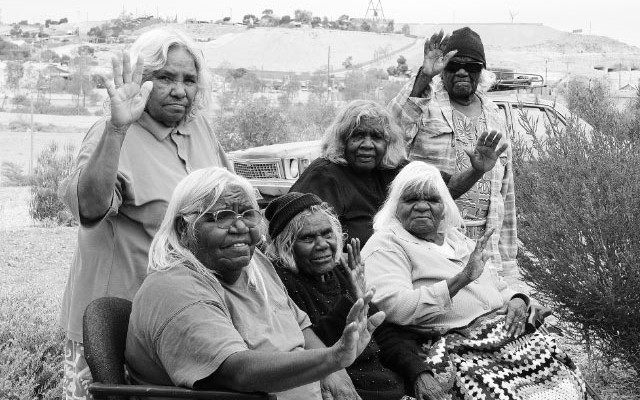I was born on Kaurna land, in a western-suburbs public hospital named after the Queen. This was the very same place where, thirty-four years later, my beloved Nanna died.
‘You know, Nats,’ I recall her saying wistfully, ‘they said I looked a bit like the Queen of England when I was young.’
‘Well, maybe,’ I replied. ‘But you were browner and more beautiful, and I don’t reckon she could roast spuds or fry squid like you!’
I have spent many hours in outpatient triage-madness, where so many of our elders die way too young from the heaviest of loads, and my heart still lurches when I drive past this hospital. Being anywhere near it triggers ‘re-memory’: the feeling of an uncanny repetition, an encounter with something deeply social and collective. Toni Morrison speaks of re-memories being ‘out there in the world’, waiting for us to bump into them so we can read the signs and know ‘the things behind the things’. Re-memories help us know the whole story.
The hospital is on route to ‘the Port’: Adelaide’s working-class industrial port of significant maritime heritage. The Outer Harbor and Lefevre Peninsula include a large tidal estuary rich in Kaurna history, culture and heritage; sites that continue to be celebrated and memorialised amongst the residential, arts and industrial mix. In the 1950s, the area became a commission housing hub for postwar migrants; many Aboriginal families, including my own, were also housed there as part of the government’s assimilation agenda.
The region is also steeped in waterside worker activism, with a long and proud history of unions standing strong with Aboriginal people. From the 1930s, coalitions were formed that fought for land rights, equal wages and broader struggles for justice. The wharves were one of the few places that Aboriginal people were employed in the first half of the twentieth century.
The port’s residents, artists and workers lent their support to a number of significant campaigns. They endorsed, for example, the nine-year Gurindji strike, also known as the Wave Hill walk-off, led by Vincent Lingiari in a defining moment for the land-rights movement; the fight against the Hindmarsh Island Bridge, during which our dignified elders endured a decade-long interrogation of their identity and culture via a state royal commission and multiple court cases; the struggle against a multi-million-dollar ‘ghetto for the rich’ housing development on a significant Kaurna campsite at Glanville; and the Irati Wanti – ‘The Poison, Leave It!’ – Campaign led by the Kupa Piti Kungka Tjuta, the council of senior Aboriginal women of Coober Pedy, which saw the successful overturning of a proposed nuclear waste dump on their land.
As a young, idealistic environmental studies student in the early 1990s I was drawn to grassroots communities fighting Western systems of social and ecological oppression. I was in awe of the Chipko ‘tree hugging’ movement in the Central Himalaya, which inspired and involved ecofeminist and non-violent activist Vandana Shiva in the 1970s and 1980s. Whole communities bravely put their bodies on the line. Supporters of the movement, mainly village women, worked collectively to end deforestation in the central Himalaya and other parts of India. They stood against the violence of globalisation, and fought bravely for their resources, economic livelihoods, biodiversity, indigenous knowledge and healthy, sustainable futures.
The courage and conviction of the Chipko women reminds me of many Indigenous leaders, past and present, who have attempted to disrupt the ongoing project of colonialism. I remember with gratitude the wise elders I have learnt from; listening to them talk around kitchen tables, at meetings, rallies and blockades, was like an apprenticeship for life. Many of us ‘younger ones’ ferried our elders between appointments and government inquiry testimonies, took notes for them in meetings, and made them endless cups of tea. They modelled strength by forming coalitions against a state that failed to recognise, understand or engage with Aboriginal knowledge systems.
In May 2016, the Nuclear Fuel Cycle Royal Commission delivered its report on the nuclear energy future of South Australia. The commission found that a nuclear waste dump could result in substantial profits, leading the government to propose a site on Adnyamathanha lands in the Flinders Ranges.
This is the point where re-memories collide. The devastation wrought by the British nuclear bomb tests at Maralinga has been largely suppressed in this state, despite the ongoing fallout. The mainstream media is mute on radioactive contamination leaks and spills into Kakadu’s world-heritage wetlands. Traditional owners also despair at disasters like Fukushima in Japan, as the uranium was sourced from their land. Yankunytjatjara traditional owners are compelled to share bittersweet lessons from the Irati Wanti Campaign, and they stand strong with the Adnyamathanha traditional owners now fighting the proposed dump.
Organisations like the No Dump Alliance have formed to fight the dump. According to its statement of concern, this Alliance formed out of respect for the traditional owners, a desire to protect the legacy of future generations, and anxieties over the public health, environmental and financial risks. Once again, the Maritime Union has joined forces to oppose the nuclear industry expansion and committed itself to protecting the fragile waterways of the Lefevre Peninsula.
Historic coalitions have been celebrated through music, song and theatre, and have been memorialised in places throughout the Port Adelaide region. These commemorations serve as symbols of solidarity and resistance. They are the ‘things behind the things’ informing the larger story. History’s lessons and hopeful futures are imprinted on this landscape. They wait for encounters, when they can carry us forward. They are the deeply social and collective re-memories that rise with tides, stir on currents, and settle with sediment. They are never still.
Image: Members of the Kupa Piti Kungka Tjuta, and the Irati Wanti campaign.
Read the rest of Overland 224
If you liked this essay, buy the issue
Or subscribe and receive
four outstanding issues for a year




